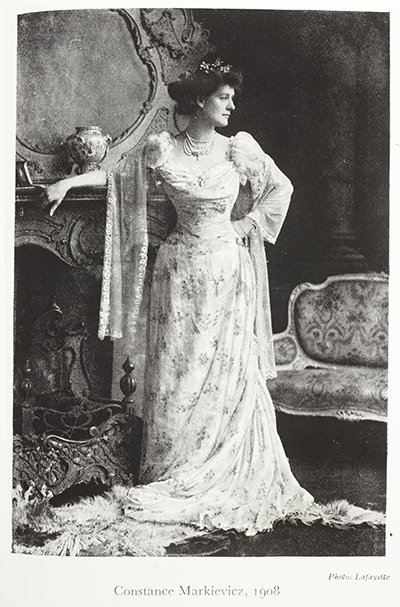
4 February 1868: Countess Constance Markievicz was born on this day. Society Girl, Artist, Revolutionary, Feminist and Socialist there is no doubt that she was a woman who lived Life to the full and gave it her all for Ireland and her People. Her parents were the Artic explorer Sir Henry Gore Booth and Lady Georgina, Lady Gore-Booth. Her father owned a large Estate at Lissadell House in Co Sligo.
In the 1890s she studied Art in London and Paris where she met her future husband, the Polish Nobleman ‘Count Markievicz’ - and there after she was known as Countess Markievicz! She gave birth to their daughter, Maeve, at Lissadell in November 1901.The family moved to Dublin in 1903 and the Countess moved in the Literary and Art circles of the city, notably in the circle of the famous portrait artist Sarah Purcell. There she met many people who were involved in the politics of the day and from this her interest in Ireland’s future deepened. In 1908, she became actively involved in nationalist politics in Ireland and joined Sinn Fein which was the most advanced Nationalist Party of its day. In 1913 Markievicz's husband moved back to Ukraine, and never returned to live in Ireland. However, they did correspond and he was by her side when she died.
When the 1916 Rising broke out she played an active part in it and was rumoured to have shot dead a DMP policeman while trying to storm Dublin Castle. She was part of the Stephens Green garrison that later withdrew to the Royal College of Surgeons on the Green. When the Rising was over she was taken prisoner, held in solitary confinement and sentenced to Death. Much to her disappointment the sentenced was commuted to Life Imprisonment. However she was released in 1917 after having served her time in an English Prison.
In the British General Election of December 1918 she was elected for a Dublin Constituency taking 66% of the vote but refused to take her seat in a London Parliament. When the 1st Dáil met in January the Countess was back in an English Prison and when the roll call was taken her absence was noted by the words - fé ghlas ag Gallaibh -"imprisoned by the foreign enemy". She was made the Minister for Labour and held that position until January 1922. She also sat in the Cabinet of the Irish Republic from April 1919 till August 1919 - thus making her the First Woman Cabinet Minister in Irish History.
She left the government in January 1922 along with Eamon De Valera and others in opposition to the Treaty. She fought actively for the Republican cause in the Irish Civil War helping to defend Moran's Hotel in Dublin. After the War she toured the United States. However, her staunch republican views led her to being sent to jail again. In prison, she and 92 other female prisoners went on hunger strike. Within a month, she was released. She joined the new Fianna Fáil on its foundation in 1926, chairing the inaugural meeting of the new party in La Scala Theatre. In the June 1927 Election she was re-elected to the Dáil as a candidate for the new party, which was pledged to return but died only five weeks later, before she could take up her seat.
Constance Markievicz died at the age of 59 on 15 July 1927, of complications related to appendicitis. She had given away the last of her wealth, and died in a public ward "among the poor where she wanted to be". One of the doctors attending her was her revolutionary colleague Kathleen Lynn. Also at her bedside were Casimir and her step-son Stanislas Markievicz, Eamon de Valera & others came by to pay their last respects. Refused a state funeral by the Free State government, she was buried Glasnevin Cemetery Dublin, and Eamon de Valera gave the funeral oration. Sean O’Casey said of her: One thing she had in abundance—physical courage; with that she was clothed as with a garment.
No comments:
Post a Comment